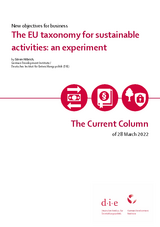The Current Column
New objectives for business
The EU taxonomy for sustainable activities: an experiment
Hilbrich, SörenThe Current Column (2022)
Bonn: German Development Institute / Deutsches Institut für Entwicklungspolitik (DIE), The Current Column of 28 March 2022
Today’s investments determine what will be produced and how in the coming decades. Financial markets can thus exert significant influence, for better or for worse, over the economic transformation towards greater sustainability. The cumbersomely titled EU taxonomy for sustainable activities could play a key role in efforts to divert capital flows into more sustainable business models. This classification system determines which economic activities are considered to be sustainable according to the EU. In order for the taxonomy to make a real contribution to greater sustainability, it is important to make its criteria sufficiently ambitious, to mainstream it effectively within other regulations and policy measures, and to take account of its global impact.
The taxonomy is intended to serve as a common language on the financial markets, better enabling investors to consider the sustainability of their investment projects when making decisions. They may be motivated in so doing by moral considerations or by a fear that unsustainable business models will no longer be profitable in future. To this end, the taxonomy defines a range of environmental (and, in future, likely also social) objectives, such as climate change mitigation and the transition to a circular economy. An activity is considered sustainable if it makes a substantial contribution to one of these objectives and does not significantly harm the achievement of the others. The conditions for this are defined very precisely for many industries (e.g. using thresholds).
However, developing a regulatory framework as extensive as the taxonomy is a highly complex undertaking and can easily give rise to the wrong kind of incentives. Unfortunately, sufficiently ambitious criteria have not always been pushed through against the vested interests of certain industries. The taxonomy’s classification of electricity generation from natural gas or nuclear power as sustainable under certain conditions received a great deal of public attention in this context. But even prior to this, several non-governmental organisations had temporarily suspended their involvement in an expert group assisting the EU with developing the taxonomy. They did so in protest at the design of the forestry and bioenergy criteria. With enthusiasm for armament now reawakened, arms lobbyists have even smelled an opportunity to have the EU recognise weapons manufacturing as making a positive contribution to social sustainability. These kinds of categorisations could significantly reduce the potential of the taxonomy to incentivise truly sustainable activities and damage its credibility in the eyes of investors.
The taxonomy’s impact will also depend on the way that it is mainstreamed within other regulations and policy measures. What is certain is that it is linked to reporting obligations. All large companies, for instance, must disclose the proportion of their turnover and operating and investment expenditure associated with activities approved by the taxonomy. Public quality seals, such as the EU Ecolabel for financial products, will also make reference to the taxonomy. Beyond such transparency measures, however, there is also discussion of other options for using the taxonomy to divert capital flows. When purchasing bonds, the European Central Bank (ECB) could, for instance, prioritise those that are taxonomy-compliant (green quantitative easing), while public banks could incorporate the taxonomy into their decision-making processes for issuing loans and making investments. Additionally, capital requirements for banks could be linked to the sustainability of their investments.
In all of this, it should also be noted that the impact of the EU taxonomy will be felt far beyond Europe’s borders. First, it will become an important standard for global financial markets because all players wishing to offer financial products on the key EU market will have to report in future on the proportion of taxonomy-compliant activities financed by their products. Second, there are several other institutions besides the EU that are currently developing a taxonomy. It should be assumed that other regions and countries will use the EU as one of their references when designing their own taxonomies. Third, the social criteria are most likely to relate in part to global supply chains. Consequently, it is essential when designing the taxonomy and refining it in future to take account of its impact on non-EU countries, though this should not lead to a lowering of standards. Dialogue and coordination with other countries are key to this end.
The EU taxonomy for sustainable activities is a grand experiment. It carries the promise to define objectives for private enterprises that go beyond the pure maximisation of profits. Milton Friedman’s claim that “the business of business is business” – and nothing other than that – shall finally no longer apply. The success of the taxonomy will depend upon whether its criteria are regularly reviewed, whether its ambition level is systematically raised in the years to come, and whether its impact, be it within or outside of the EU, is closely monitored.


